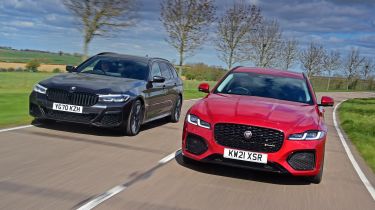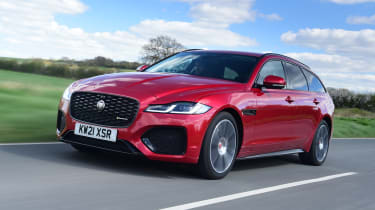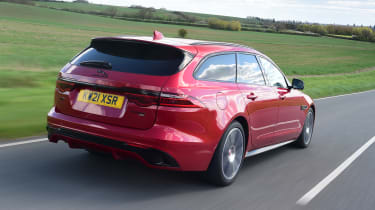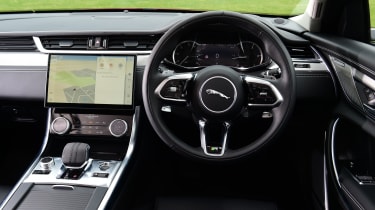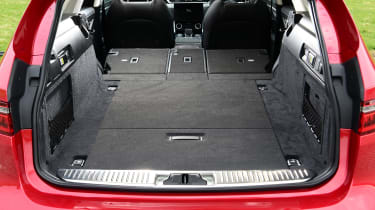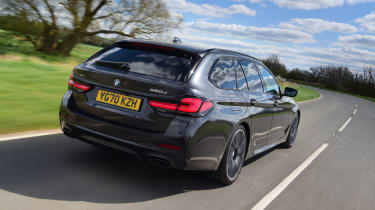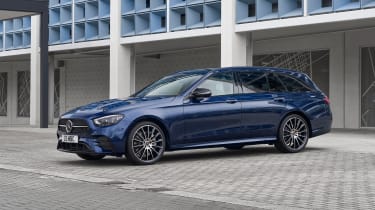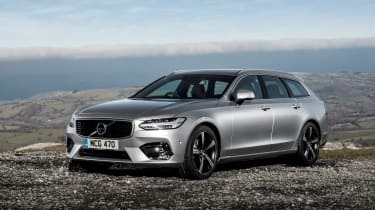BMW 5 Series Touring vs Jaguar XF Sportbrake
With SUV popularity increasing, estates like the BMW 5 Series Touring and Jaguar XF Sportbrake have it harder than ever - but which is best?
If you want a practical family car that’s also luxurious and upmarket, but aren’t convinced by large SUVs, then an executive estate car is as good as it gets. These models have all the comforts of premium saloon cars, but with a wide-opening tailgate – great for dog owners – and a larger boot.
The latest large estate on the market is the Jaguar XF Sportbrake, which has been updated for 2021 with new technology and equipment – and it’s better than ever.
The Jaguar has been impressive in the past when we’ve tested it, but it has its work cut out to beat our favourite executive estate, the BMW 5 Series Touring. This model is one of very few cars that offers something for nearly anyone, because it’s fantastic in just about every key area – so it’s going to be a tough test for Jaguar if it wants to take the crown in this class.
Jaguar is pushing towards an electric future, but for now there’s no plug-in hybrid version of the XF, unlike with the 5 Series. This means that drivers wanting to save money on running costs will have to go for the diesel model, which is what we’re testing here.
Used - available now

2020 Ford
Focus
46,802 milesManualPetrol1.5L
Cash £14,296
2022 Ford
Focus
18,350 milesManualPetrol1.0L
Cash £17,076
2022 Kia
e-Niro
25,164 milesAutomaticElectric
Cash £15,799
2021 Peugeot
108
23,000 milesManualPetrol1.0L
Cash £8,449The winner will need to combine comfort, practicality, luxury, equipment and driving dynamics, because these estate cars are meant to be all-rounders that excel in just about every situation. Let’s find out which one is best.
Jaguar XF Sportbrake
| Jaguar XF Sportbrake D200 R-Dynamic SE AWD | |
| Price: | £40,345 |
| Engine: | 2.0-litre 4cyl diesel, 201bhp |
| 0-62mph: | 8.0 seconds |
| Test economy: | 51.4mpg/11.3mpl |
| CO2: | 155g/k |
| Annual road tax: | £490 |
The Jaguar XF Sportbrake has been upgraded but prices have actually dropped. Our pictures show an R-Dynamic S, which is no longer offered, but even in R-Dynamic SE AWD spec as tested here, at £40,345 it’s still cheaper than the BMW.
Design & engineering
The latest XF Sportbrake isn’t a radical redesign, but it was a good-looking car in the first place, and it’s even sharper now. The main upgrades we’re interested in are the improved interior, new equipment and technology, such as the mild-hybrid system added to the powertrain. As with many new cars – including the BMW 520d here – there’s a 48V electrical system with a starter-generator to provide a small boost to economy and performance.
The Sportbrake also benefits from self-levelling air suspension at the rear, which is fitted to a multi-link set-up, while the front suspension features double wishbones, the same layout as the BMW. Aluminium construction keeps weight down, improving handling and performance, but the XF is still heavier than the BMW, weighing 1,856kg compared with 1,840kg; neither is light.
There’s plenty of shove from the engine, because the D200 model has a 2.0-litre turbodiesel with 201bhp and 430Nm of torque. It’s the more powerful car here, although you have to rev the engine higher to access peak power.
This model is the AWD version, so all four wheels are driven. It’s no SUV, but it delivers good traction and could be useful in poor weather. There’s also an eight-speed automatic gearbox, just like in the BMW.
The new XF Sportbrake’s interior is a big improvement over the previous model’s. While the fit and finish is as good as before, the upgraded Pivi Pro infotainment system looks better, is faster and easier to use, and brings a more modern look to the cabin. Small changes such as the new steering wheel and different gearshifter are good to see as well.
Standard kit is good – the 11.4-inch screen is standard on all cars, plus there are 18-inch alloys, LED lights, a parking camera, lane-keep assist, AEB, heated leather seats and two-zone climate control. The R-Dynamic model also has sportier styling, upgraded seats and different wheels.
Driving
The XF has always been good to drive, and this latest version is better than ever. It offers a fantastic balance of ride quality and handling, bringing plenty of comfort as well as an enjoyable driving experience.
Only the harshest potholes upset the car’s balance; over rough B-roads, the XF is largely smooth and composed. In fact the faster you go, the better it feels. On a flowing road or motorway it’s very comfortable.
The XF’s steering is well weighted and quick, and it beats the BMW in this area – there’s more feel and the wheel is more pleasant to hold than the spongy rim of the 5 Series. Body control is good, too, so the Jaguar feels more agile than you might expect given its size and weight. It’s not a lightweight car, but it disguises its mass well – although so does the BMW.
The engine is quieter than it was in previous XFs, but it’s still not as smooth as the one in the 520d. It delivers good power, at 201bhp, but the XF is actually slower from 0-62mph than the BMW. The Jag takes 8.0 seconds, but the less powerful 520d manages it in 7.6 seconds – this is down to the gearbox, because the BMW’s transmission feels much more responsive.
The XF’s eight-speed unit is smooth in most situations, and is nicely refined, but at other times it can feel lethargic where the BMW’s box excels. For example, if you slow for a junction and see that it’s clear, then put your foot down again, the Jag’s gearbox can take a couple of seconds to react. It’s frustrating, but it’s not a huge issue.
Practicality
There are 563 litres of space in the boot, so the Jaguar is marginally smaller than the previous version by two litres. However, it’s still three litres bigger than the BMW with the seats in place. In the real world, it’s fair to say these cars have the same amount of space in the back.
The XF’s high roofline and wide boot opening means loading items is easy, and they’re great for dog owners or golfers as a result.
The back seats are roomy enough for adults, but it feels darker inside than the BMW, so rear-seat passengers might feel slightly more cramped. Both cars have the same towing capacity of 2,000kg, and the XF’s punchy diesel should be more than capable of pulling a heavy trailer.
Ownership
Jaguar’s seventh-place finish in our 2021 Driver Power manufacturers’ survey is far better than BMW’s 21st-place result, so it seems that you’re more likely to be satisfied with the XF’s ownership experience.
The XF Sportbrake hasn’t been tested specifically by Euro NCAP, but the saloon was tested in 2015 and scored the full five stars. Standard safety kit is good – there are two pairs of Isofix points in the outer rear seats, parking sensors all round, a reversing camera and autonomous emergency braking. On R-Dynamic SE trim blind-spot warning is also standard, but it’s optional on the BMW.
Running costs
The new D200 mild-hybrid diesel engine in the XF was really economical on test, returning 51.4mpg, although this was mostly motorway miles. The BMW wasn’t far off, at 47.8mpg, but the Jag’s return is still impressive. It works out at £1,371 per year if you do 12,000 miles (that’s at current fuel prices), while the BMW will cost £1,475 per year over the same distance.
Both cars are in the same insurance group, 35, and they have the same three-year, unlimited-mileage warranty, so some of the other costs of motoring shouldn’t be too different between the two.
Testers’ notes
“The Jaguar’s cabin feels less cramped than it did before, especially up front, but it’s still cosy rather than roomy – some will prefer that, though.”
BMW 5 Series Touring
| BMW 520d xDrive Touring SE | |
| Price: | £44,555 |
| Engine: | 2.0-litre 4cyl diesel, 187bhp |
| 0-62mph: | 7.6 seconds |
| Test economy: | 47.8mpg/10.5mpl |
| CO2: | 141g/km |
| Annual road tax: | £490 |
Although our pictures show a BMW 520d in M Sport trim, it’s the SE model we’re testing here, because it’s closer to the Jaguar’s price, at £44,555. It’s an xDrive model, so it matches the XF’s four-wheel-drive layout, but the BMW loses ground initially because it’s the more expensive car.
Design & engineering
The whole 5 Series range was revised last year, although it was a less extensive update than Jaguar has made with the new XF; the BMW is based on the same platform as before. As with the Jaguar, it has double-wishbone front suspension and a multi-link set-up at the rear – and the xDrive badge on the back means it has four-wheel drive.
The update did bring some interior tweaks and smarter looks, as well as mild-hybrid tech for the four-cylinder 520d. This adds a 48V electric set-up which helps the engine deliver lower emissions. The 187bhp 2.0-litre diesel is 14bhp down on the Jaguar, but maximum power arrives at 4,000rpm, as opposed to 4,250rpm in the XF. The BMW is also behind for torque: there’s 400Nm here, 430Nm in the XF.
Cabin quality in the BMW is superb, with an excellent finish and a spacious feel, as well as plenty of high-grade materials that help to justify the car’s premium price tag. It’s got a digital dash and an excellent infotainment screen that matches the Jaguar’s new set-up, although some key features are only available as part of option packs. For example, wireless charging is £300 in the XF, but you have to buy a £2,495 option pack to get it in the BMW.
Standard equipment is still very good, even on the SE model. It comes with a rear camera, automatic emergency braking, climate and cruise control, sat-nav, a powered tailgate, smartphone connectivity, LED headlights, 17-inch alloys and heated seats.
Driving
The BMW 5 Series Touring is one of the best all-rounders you can buy at any price point. It’s good at everything you could want, delivering luxury-car levels of comfort and a genuinely enjoyable driving experience at the same time.
On a twisty road you can enjoy the precise and well weighted steering, excellent body control and punchy diesel performance, yet the car settles into an incredibly relaxing cruise on motorway trips. Even on models without adaptive dampers, the 5 Series has a brilliant balance of ride and handling. The XF is one of the few cars that manages to come close to it, because it’s also fantastic at all kinds of driving, but the BMW is just a little more refined, quieter and more comfortable, especially at higher speeds.
One thing we did discover with the M Sport car in our pictures was that on the larger 20-inch alloys, the BMW thuds into potholes more harshly than the Jaguar. However, from past experience with the SE model and its smaller alloys, we know that this is much better, thanks to the taller tyre sidewalls.
BMW’s 187bhp 2.0-litre diesel is very refined, especially at low speed, and it’s smoother than Jaguar’s diesel. It doesn’t need to be revved to get the best from it, and the eight-speed automatic gearbox exploits this by shifting smoothly in auto mode and quickly in manual mode, which adds to the engaging driving experience without taking away from comfort.
The BMW’s gearbox is more responsive than the Jaguar’s, because it’s quicker to react when you put your foot down or use the paddles in manual mode. This is why the 0-62mph time for the BMW is 7.6 seconds, 0.4 seconds faster than the Jaguar’s time, despite the British model having more power and torque. On the road, neither car feels significantly faster than the other, though – both have more than enough grunt to get you moving quickly.
Practicality
The BMW has a 560-litre boot with the rear bench in place, which is about the same as in the Jaguar. It’s a similar story with the seats folded down, with 1,700 litres in the back of the 520d and 1,695 litres in the XF Sportbrake, so it’s pretty much a draw for luggage space.
There’s a powered tailgate as standard on the 520d, but the BMW has an ace up its sleeve because the rear glass opens separately, so you don’t need to open the boot completely to put smaller items in. With the tailgate open there’s no loading lip.
There’s lots of leg and shoulder room in the back, and the seats themselves are set nice and low in the cabin so headroom is good, whether you’re in the front or rear. The driving position is fantastic, too.
Ownership
BMW came in a poor 21st place in our 2021 Driver Power survey, and its dealers came in 19th in that section of the poll in 2020 – behind Jaguar’s seventh and ninth places respectively. That’s pretty damning for the German brand, but we have no reason to suspect that the 5 Series will be less reliable than the XF.
You don’t get lane-keep assist as standard on the 520d SE, which means the XF is better equipped for safety. However all the essentials are present on the BMW, including AEB, parking sensors, six airbags and a reversing camera, while a five-star Euro NCAP score matches the Jaguar’s.
Running costs
Higher-rate earners will pay £5,669 a year in company car tax for this 520d Touring, which means it’s more expensive than the Jaguar, which costs £5,563. This is because the Jag has a lower list price, rather than because of emissions – the BMW is actually in a lower tax bracket than its rival (they’re in the 32 per cent and 35 per cent brackets respectively).
The BMW will be worth £21,774 after three years or 36,000 miles according to our experts, while the Jaguar will be worth £18,926 after the same period. That’s a residual value of 48.9 per cent for the former and 46.9 per cent for the latter.
Testers’ notes
“If company car tax is a factor, the BMW is available as a plug-in hybrid with ultra-low rates – but there’s no such option in the Jaguar XF range.”
Verdict
First place: BMW 5 Series Touring
The gap between these two incredible do-everything cars is smaller than ever, but the BMW is still our pick. It’s just as good to drive and as comfortable as the Jaguar, but it has a smoother, quieter engine and a more responsive gearbox. Since practicality is virtually identical and a price advantage for the Jag is dulled by PCP offers and poorer tech, the BMW manages to hold off the updated XF, but only just.
Second place: Jaguar XF Sportbrake
The sharp-looking, great-driving and economical XF Sportbrake is one of the best cars Jaguar makes – it’s just that its rival here is one of the best all-round cars you can buy. The XF is great to drive, well equipped, has a much better interior than before and is just as practical as its rival. It’s a fantastic car, and we wouldn’t blame anyone if they chose it over a 5 Series.
Also consider...
Mercedes E-Class Estate
- Mercedes E 220 d Sport
- Price: £41,685
- Engine: 2.0-litre 4cyl, 191bhp
If you want more space in the boot, the E-Class Estate is the place to go. As with all the rivals here it’s also been facelifted recently, and while it’s not as good to drive as the others it does have a 640-litre boot that expands to 1,820 litres.
- Volvo V90 B4 (D) FWD Momentum
- Price: £42,385
- Engine: 2.0-litre 4cyl, 187bhp
The V90 was also updated recently, but the changes were pretty minor. It’s a more comfortable alternative to the BMW and Jaguar, with less of a focus on handling. It has a minimalist but high-quality cabin and is a great motorway cruiser.
Figures
| BMW 520d xDrive Touring SE | Jaguar XF Sportbrake D200 R-Dynamic SE AWD | |
| On the road price/total as tested | £44,555/£44,555 | £40,345/£40,345 |
| Residual value (after 3yrs/36,000) | £21,774/48.9% | £18,926/46.9% |
| Depreciation | £22,781 | £21,419 |
| Annual tax liability std/higher rate | £2,835/£5,669 | £2,781/£5,563 |
| Annual fuel cost (12k/20k miles) | £1,542/£2,569 | £1,433/£2,388 |
| Ins. group/quote/VED | 35/£570/£490 | 35/£487/£490 |
| Cost of 1st/2nd/3rd service | £25pm (3yrs) | N/A |
| Length/wheelbase | 4,963/2,975mm | 4,694/2,960mm |
| Height/width | 1,498/1,868mm | 1,494/1,982mm |
| Engine | 4cyl in-line/1,995cc | 4cyl in-line/1,997cc |
| Peak power/revs | 187/4,000 bhp/rpm | 201/4,250 bhp/rpm |
| Peak torque/revs | 400/1,750 Nm/rpm | 430/1,750 Nm/rpm |
| Transmission | 8-speed auto/4wd | 8-speed auto/4wd |
| Fuel tank capacity/spare wheel | 66 litres/repair kit | 66 litres/repair kit |
| Boot capacity (seats up/down) | 560/1,700 litres | 563/1,695 litres |
| Kerbweight/payload/towing weight | 1,840/N/A/2,000kg | 1,856/594/2,000kg |
| Turning circle | 12.4 metres | 11.6 metres |
| Basic warranty (miles)/recovery | 3yrs (unlimited)/3yrs | 3yrs (unlimited)/3yrs |
| Driver Power manufacturer/dealer pos | 27th/19th | 12th/9th |
| NCAP: Adult/child/ped./assist/stars | 91/85/81/59/5 (’17) | 92/84/80/83/5 (’15) |
| 0-62mph/top speed | 7.6 secs/138mph | 8.0 secs/143mph |
| Auto Express economy/range | 47.8/10.5/694 miles | 51.4/11.3/746 miles |
| WLTP combined | 50.4-52.3mpg | 45.8-49.5mpg |
| WLTP combined | 11.1-11.5mpl | 10.1-10.9mpl |
| Actual/claimed CO2/tax bracket | 158/141g/km/32% | 147/155g/km/35% |
| Airbags/Isofix/park sensors/camera | Six/yes/yes/yes | Six/yes/yes/yes |
| Auto box/lane keep/blindspot/AEB | Y/£4,995*/£4,995*/y | Yes/yes/yes/yes |
| Climate control/adaptive cruise | Yes/yes | Yes/yes |
| Leather/heated seats | Yes/yes | Yes/yes |
| Met paint/LED lights | £900/yes | £700/yes |
| Keyless entry & go/pwr tailgate | £2,495*/yes | Yes/yes |
| Sat-nav/digital dash | Yes/yes | Yes/yes |
| DAB/connected services | Yes/yes | yes/yes |
| Wireless charge/CarPlay/Android Auto | £2,495*/yes/yes | £300/yes/yes |
